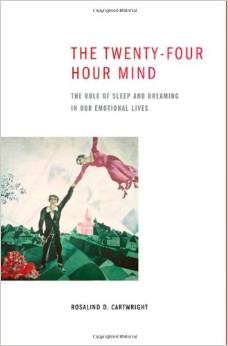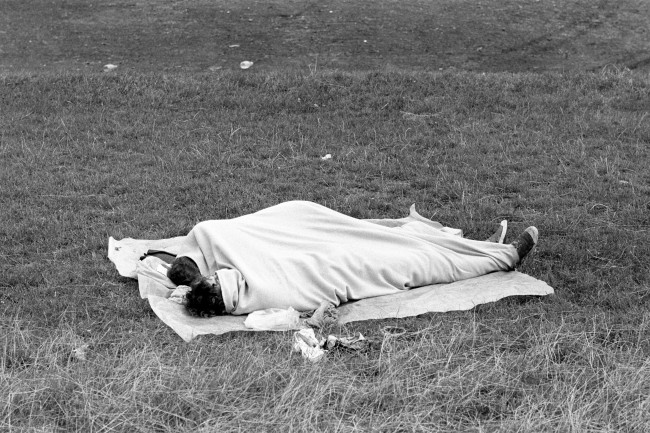REM, Depression And Genius: The Twenty-four Hour Mind
In Rosalind D. Cartwright’s The Twenty-four Hour Mind: The Role of Sleep and Dreaming in Our Emotional Lives, she turns to a link between REM sleep and depression:
The more severe the depression, the earlier the first REM begins. Sometimes it starts as early as 45 minutes into sleep. That means these sleepers’ first cycle of NREM sleep amounts to about half the usual length of time. This early REM displaces the initial deep sleep, which is not fully recovered later in the night. This displacement of the first deep sleep is accompanied by an absence of the usual large outflow of growth hormone. The timing of the greatest release of human growth hormone (HGH) is in the first deep sleep cycle. The depressed have very little SWS [slow-wave sleep, Stages 3 and 4 of the sleep cycle] and no big pulse of HGH; and in addition to growth, HGH is related to physical repair. If we do not get enough deep sleep, our bodies take longer to heal and grow. The absence of the large spurt of HGH during the first deep sleep continues in many depressed patients even when they are no longer depressed (in remission).
The first REM sleep period not only begins too early in the night in people who are clinically depressed, it is also often abnormally long. Instead of the usual 10 minutes or so, this REM may last twice that. The eye movements too are abnormal — either too sparse or too dense. In fact, they are sometimes so frequent that they are called eye movement storms.
 The depressed have trouble recalling their dreams. They recall nothing.
The depressed have trouble recalling their dreams. They recall nothing.
Brain imaging technology has helped to shed light on this mystery. Scanning depressed patients while they sleep has shown that the emotion areas of the brain, the limbic and paralimbic systems, are activated at a higher level in REM than when these patients are awake. High activity in these areas is also common in REM sleep in nondepressed sleepers, but the depressed have even higher activity in these areas than do healthy control subjects. This might be expected — after all, while in REM these individuals also show higher activity in the executive cortex areas, those associated with rational thought and decision making. Nondepressed controls do not exhibit this activity in their REM brain imaging studies. This finding has been tentatively interpreted… as perhaps a response to the excessive activity in the areas responsible for emotions.
The need for dreams?
Despite differences in terminology, all the contemporary theories of dreaming have a common thread — they all emphasize that dreams are not about prosaic themes, not about reading, writing, and arithmetic, but about emotion, or what psychologists refer to as affect. What is carried forward from waking hours into sleep are recent experiences that have an emotional component, often those that were negative in tone but not noticed at the time or not fully resolved. One proposed purpose of dreaming, of what dreaming accomplishes (known as the mood regulatory function of dreams theory) is that dreaming modulates disturbances in emotion, regulating those that are troublesome. My research, as well as that of other investigators in this country and abroad, supports this theory. Studies show that negative mood is down-regulated overnight. How this is accomplished has had less attention.
I propose that when some disturbing waking experience is reactivated in sleep and carried forward into REM, where it is matched by similarity in feeling to earlier memories, a network of older associations is stimulated and is displayed as a sequence of compound images that we experience as dreams. This melding of new and old memory fragments modifies the network of emotional self-defining memories, and thus updates the organizational picture we hold of ‘who I am and what is good for me and what is not.’ In this way, dreaming diffuses the emotional charge of the event and so prepares the sleeper to wake ready to see things in a more positive light, to make a fresh start. This does not always happen over a single night; sometimes a big reorganization of the emotional perspective of our self-concept must be made — from wife to widow or married to single, say, and this may take many nights. We must look for dream changes within the night and over time across nights to detect whether a productive change is under way. In very broad strokes, this is the definition of the mood-regulatory function of dreaming, one basic to the new model of the twenty-four hour mind I am proposing.
Keeping balance:
[In] good sleepers, the mind is continuously active, reviewing experience from yesterday, sorting which new information is relevant and important to save due to its emotional saliency. Dreams are not without sense, nor are they best understood to be expressions of infantile wishes. They are the result of the interconnectedness of new experience with that already stored in memory networks. But memory is never a precise duplicate of the original; instead, it is a continuing act of creation. Dream images are the product of that creation. They are formed by pattern recognition between some current emotionally valued experience matching the condensed representation of similarly toned memories. Networks of these become our familiar style of thinking, which gives our behavior continuity and us a coherent sense of who we are. Thus, dream dimensions are elements of the schemas, and both represent accumulated experience and serve to filter and evaluate the new day’s input.
Sleep is a busy time, interweaving streams of thought with emotional values attached, as they fit or challenge the organizational structure that represents our identity. One function of all this action, I believe, is to regulate disturbing emotion in order to keep it from disrupting our sleep and subsequent waking functioning.
A study ealier this year indicates that “if you’re in the mindset that you’re well-rested, your brain will perform better, regardless of the actual quality of your sleep”:
Participating undergrads first reported how deeply they’d slept the night before, on a scale of one to 10. The researchers then gave the participants a quick, five-minute lesson about sleep’s effect on cognitive function, telling them it was just background information for the study. … Then participants were hooked up to equipment that they were told would read their pulse, heartrate, and brainwave frequency, though it actually just measured their brainwave frequency. They were told that these measurements would allow the researchers to tell how much REM sleep they’d gotten the night before. This was not true. …
Participants who were told they had above-average REM sleep performed better on the test, and those who were told their REM sleep was below average performed worse, even when researchers controlled for the subjects’ self-reported sleep quality.
And sleep help the genius:
[R]esearchers gave a group of students a tedious task that involved transforming a long list of number strings into a new set of number strings. Wagner and Born designed the task so that there was an elegant shortcut, but it could only be uncovered if the subject had an insight about the problem. When people were left to their own devices, less than twenty per cent of them found the shortcut, even when given several hours to mull over the task. The act of dreaming, however, changed everything: after people were allowed to lapse into R.E.M. sleep, nearly sixty per cent of them discovered the secret pattern.
Spotter: Maria Popova, The Twenty-four Hour Mind
Posted: 20th, November 2014 | In: Technology Comment | TrackBack | Permalink



